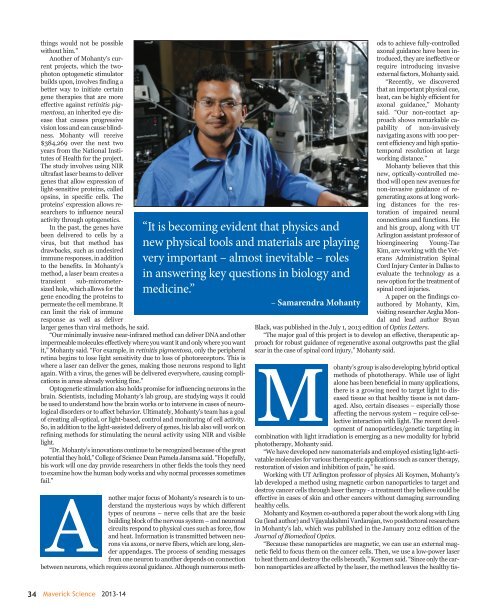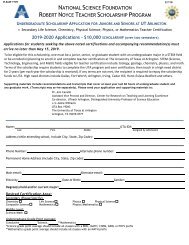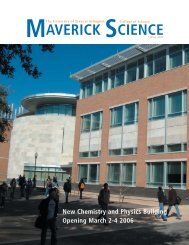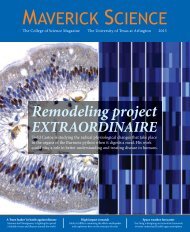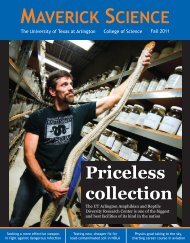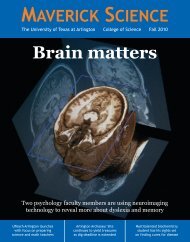Maverick Science mag 2013-14
You also want an ePaper? Increase the reach of your titles
YUMPU automatically turns print PDFs into web optimized ePapers that Google loves.
things would not be possible<br />
without him.”<br />
Another of Mohanty’s current<br />
projects, which the twophoton<br />
optogenetic stimulator<br />
builds upon, involves finding a<br />
better way to initiate certain<br />
gene therapies that are more<br />
effective against retinitis pigmentosa,<br />
an inherited eye disease<br />
that causes progressive<br />
vision loss and can cause blindness.<br />
Mohanty will receive<br />
$384,269 over the next two<br />
years from the National Institutes<br />
of Health for the project.<br />
The study involves using NIR<br />
ultrafast laser beams to deliver<br />
genes that allow expression of<br />
light-sensitive proteins, called<br />
opsins, in specific cells. The<br />
proteins’ expression allows researchers<br />
to influence neural<br />
activity through optogenetics.<br />
In the past, the genes have<br />
been delivered to cells by a<br />
virus, but that method has<br />
drawbacks, such as undesired<br />
immune responses, in addition<br />
to the benefits. In Mohanty’s<br />
method, a laser beam creates a<br />
“It is becoming evident that physics and<br />
new physical tools and materials are playing<br />
very important – almost inevitable – roles<br />
in answering key questions in biology and<br />
medicine.”<br />
– Samarendra Mohanty<br />
transient sub-micrometersized<br />
hole, which allows for the<br />
gene encoding the proteins to<br />
permeate the cell membrane. It<br />
can limit the risk of immune<br />
response as well as deliver<br />
larger genes than viral methods, he said.<br />
“Our minimally invasive near-infrared method can deliver DNA and other<br />
impermeable molecules effectively where you want it and only where you want<br />
it,” Mohanty said. “For example, in retinitis pigmentosa, only the peripheral<br />
retina begins to lose light sensitivity due to loss of photoreceptors. This is<br />
where a laser can deliver the genes, making those neurons respond to light<br />
again. With a virus, the genes will be delivered everywhere, causing complications<br />
in areas already working fine.”<br />
Optogenetic stimulation also holds promise for influencing neurons in the<br />
brain. Scientists, including Mohanty’s lab group, are studying ways it could<br />
be used to understand how the brain works or to intervene in cases of neurological<br />
disorders or to affect behavior. Ultimately, Mohanty’s team has a goal<br />
of creating all-optical, or light-based, control and monitoring of cell activity.<br />
So, in addition to the light-assisted delivery of genes, his lab also will work on<br />
refining methods for stimulating the neural activity using NIR and visible<br />
light.<br />
“Dr. Mohanty's innovations continue to be recognized because of the great<br />
potential they hold," College of <strong>Science</strong> Dean Pamela Jansma said. "Hopefully,<br />
his work will one day provide researchers in other fields the tools they need<br />
to examine how the human body works and why normal processes sometimes<br />
fail.”<br />
A<br />
nother major focus of Mohanty’s research is to understand<br />
the mysterious ways by which different<br />
types of neurons – nerve cells that are the basic<br />
building block of the nervous system – and neuronal<br />
circuits respond to physical cues such as force, flow<br />
and heat. Information is transmitted between neurons<br />
via axons, or nerve fibers, which are long, slender<br />
appendages. The process of sending messages<br />
from one neuron to another depends on connection<br />
between neurons, which requires axonal guidance. Although numerous methods<br />
to achieve fully-controlled<br />
axonal guidance have been introduced,<br />
they are ineffective or<br />
require introducing invasive<br />
external factors, Mohanty said.<br />
“Recently, we discovered<br />
that an important physical cue,<br />
heat, can be highly efficient for<br />
axonal guidance,” Mohanty<br />
said. “Our non-contact approach<br />
shows remarkable capability<br />
of non-invasively<br />
navigating axons with 100 percent<br />
efficiency and high spatiotemporal<br />
resolution at large<br />
working distance.”<br />
Mohanty believes that this<br />
new, optically-controlled method<br />
will open new avenues for<br />
non-invasive guidance of regenerating<br />
axons at long working<br />
distances for the restoration<br />
of impaired neural<br />
connections and functions. He<br />
and his group, along with UT<br />
Arlington assistant professor of<br />
bioengineering Young-Tae<br />
Kim, are working with the Veterans<br />
Administration Spinal<br />
Cord Injury Center in Dallas to<br />
evaluate the technology as a<br />
new option for the treatment of<br />
spinal cord injuries.<br />
A paper on the findings coauthored<br />
by Mohanty, Kim,<br />
visiting researcher Argha Mondal<br />
and lead author Bryan<br />
Black, was published in the July 1, <strong>2013</strong> edition of Optics Letters.<br />
“The major goal of this project is to develop an effective, therapeutic approach<br />
for robust guidance of regenerative axonal outgrowths past the glial<br />
scar in the case of spinal cord injury,” Mohanty said.<br />
M<br />
ohanty’s group is also developing hybrid optical<br />
methods of phototherapy. While use of light<br />
alone has been beneficial in many applications,<br />
there is a growing need to target light to diseased<br />
tissue so that healthy tissue is not da<strong>mag</strong>ed.<br />
Also, certain diseases – especially those<br />
affecting the nervous system – require cell-selective<br />
interaction with light. The recent development<br />
of nanoparticles/genetic targeting in<br />
combination with light irradiation is emerging as a new modality for hybrid<br />
phototherapy, Mohanty said.<br />
“We have developed new nanomaterials and employed existing light-activatable<br />
molecules for various therapeutic applications such as cancer therapy,<br />
restoration of vision and inhibition of pain,” he said.<br />
Working with UT Arlington professor of physics Ali Koymen, Mohanty’s<br />
lab developed a method using <strong>mag</strong>netic carbon nanoparticles to target and<br />
destroy cancer cells through laser therapy - a treatment they believe could be<br />
effective in cases of skin and other cancers without da<strong>mag</strong>ing surrounding<br />
healthy cells.<br />
Mohanty and Koymen co-authored a paper about the work along with Ling<br />
Gu (lead author) and Vijayalakshmi Vardarajan, two postdoctoral researchers<br />
in Mohanty’s lab, which was published in the January 2012 edition of the<br />
Journal of Biomedical Optics.<br />
“Because these nanoparticles are <strong>mag</strong>netic, we can use an external <strong>mag</strong>netic<br />
field to focus them on the cancer cells. Then, we use a low-power laser<br />
to heat them and destroy the cells beneath,” Koymen said. “Since only the carbon<br />
nanoparticles are affected by the laser, the method leaves the healthy tis-<br />
34 <strong>Maverick</strong> <strong>Science</strong> <strong>2013</strong>-<strong>14</strong>


